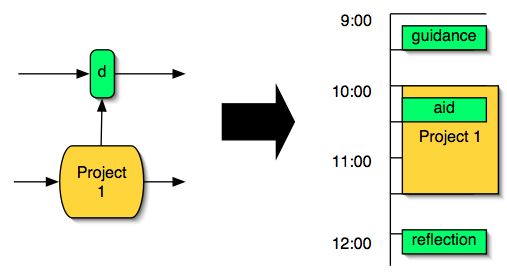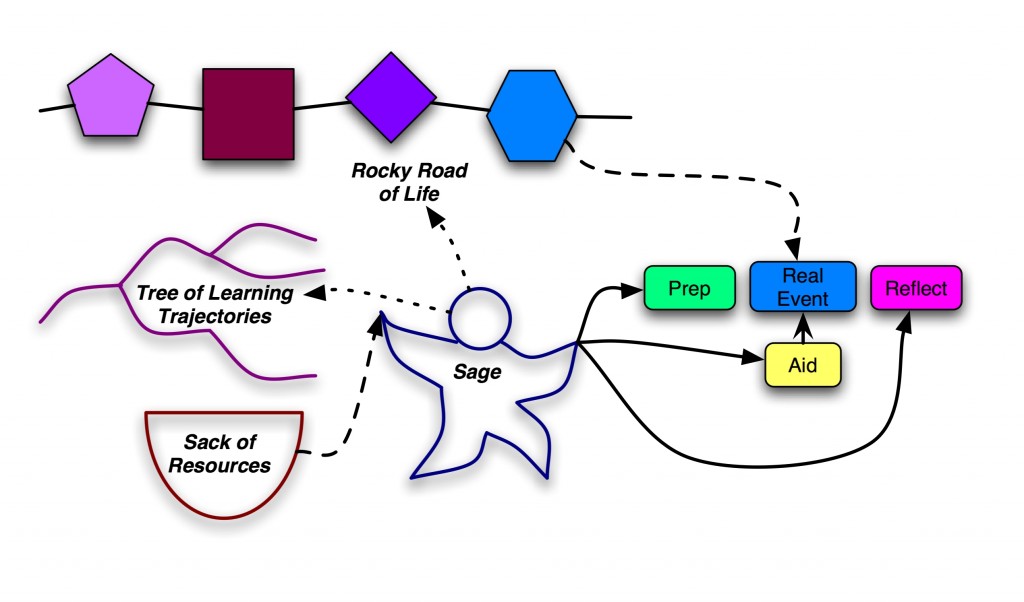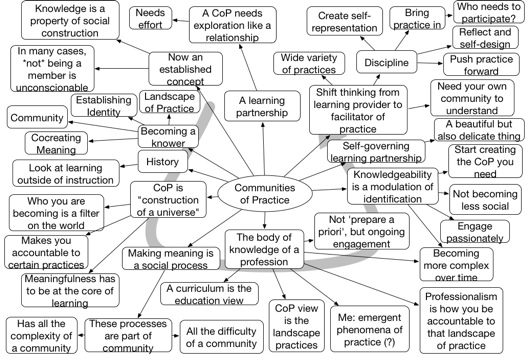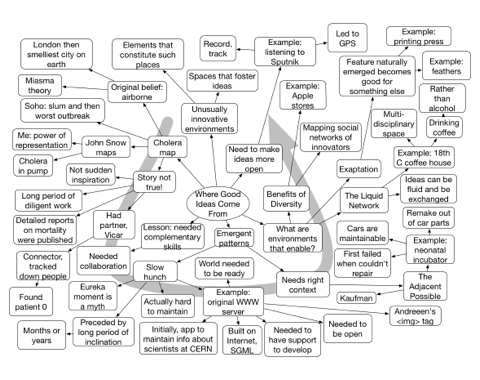At the CSTD meeting, Etienne was the morning keynote, and gave a erudite exploration of the philosophical background and characteristics of Communties of Practice.
Stephen Berlin Johnson Keynote Mindmap
Here at the very friendly Canadian Society for Training & Development annual conference, Stephen Berlin Johnson gave a great keynote telling the story of innovation. In it, he busted the myth of individual inspiration and instead pointed to the contributions of the slow hunch, diverse inputs, and continual communication & collaboration.
Layered Learning
Last week, I posted about a model where a system could provide a sage who looks at the events of your life and provides support. I want to elaborate that model by looking at it in a different way.
 The notion here is that you have events in your life, across the bottom. And you have some learning goals, e.g. to learn about project management, and about running meetings. You might get some initial content about those two goals, but then let’s focus on developing that learning over time.
The notion here is that you have events in your life, across the bottom. And you have some learning goals, e.g. to learn about project management, and about running meetings. You might get some initial content about those two goals, but then let’s focus on developing that learning over time.
The events in your life give you a chance to use them as learning experiences, not just performance opportunities. If there are not enough in your life, you might have interstitial activities (those in dashed lines), but you can be developed across learning goals abcd, and uvwxyz, both through delivered experiences, and with learning wrapped around real experiences.
 Let me make that latter clearer. Say you’ve got some event like project work, and an associated learning goal (e.g. concept ‘d’ in a curricula). A system could see the calendar entry for the project work and, through tagging or other semantic means, recognize the relationship with learning goal ‘d’. Then, some relevant activation and concept material might precede the event, an aid could appear during, and either a self-evaluation metric or a connection to a live person could happen afterward. Delivered, for instance, through mobile devices.
Let me make that latter clearer. Say you’ve got some event like project work, and an associated learning goal (e.g. concept ‘d’ in a curricula). A system could see the calendar entry for the project work and, through tagging or other semantic means, recognize the relationship with learning goal ‘d’. Then, some relevant activation and concept material might precede the event, an aid could appear during, and either a self-evaluation metric or a connection to a live person could happen afterward. Delivered, for instance, through mobile devices.
The goal is to use the events in your life as learning opportunities as much as possible (or preferable). We can also mix in some simulated practice (e.g an alternate reality game) if it’s not occurring at a sufficient rate in real life, but the goal is to match the learning development plan to the rate at which we effectively learn. And, to be clear, we do not learn effectively by a one-off knowledge dump and a quiz, as much of what we do actually works out to be.
As I’ve mentioned before, we have the magic, the sufficiently advanced technology Arthur C. Clarke talked about, to hand. We should start using it to develop us towards our goals in appropriate ways. The opportunity is there; who’s ready to seize it?
Sage at the Side
A number of years ago, I wrote an article (PDF) talking about how we might go beyond our current ‘apart’ learning experiences. The notion is what I call ‘layered learning’, where we don’t send you away from your life to go attend a learning event, but instead layer it around the events in your life. This is very much part of what I’ve been calling slow learning, and a recent conversation has catalyzed and crystalized that thought.

Think about the sort of ideal learning experience you might have. As you traverse the ‘rocky road’ of life, imagine having a personal coach who would observe the situation, understand the context of the task and the desired goal, and could provide some aid (from some sack of resources) that could assist you in immediate performance. Your performance would improve.
Let’s go further. This sage, moreover, could draw from some curricula (learning trajectories) and prepare you beforehand and guide reflection afterward so that real performance event now becomes a learning opportunity as well, helping you understand why this particular approach makes sense, how to adapt it, and more. In this way, the sage moves from performance coach to learning mentor.
One step further would be to have learning trajectories not only about the domain (e.g. engineering) but also about quality, management, learning, and more. So learners could be developed as learners, and as persons, not just as performers.
Now this would be ideal, but individual mentors don’t scale very well. But here’s the twist: we can build this. We can have curricula, learning objects, and build a sage via rules that can do this. Imagine going through your workday with a device (e.g. an app phone or a small tablet) that knows what you’re doing (from your calendar), which triggers content to be served up before, during, and after tasks, that develops you over time. We can build the tutor, develop and access the curricula and content, deliver it, track it.
I hope this is clear. There are other ways to think about this, and I’ll see if I can’t capture them in some way; stay tuned. The limitations are no longer the technology, the limits are between our ears. Reckon?
Book Review Pointer
In case you didn’t see it, eLearn Mag has posted my book review of Mark Warschauer’s insightful book, Learning in the Cloud. To quote myself:
This is … a well-presented, concise, and documented presentation of just what is needed to make a working classroom, and how technology helps.
As one more teaser, let me provide the closing paragraph:
The ultimate message, however, is that this book is important, even crucial reading. This is a book that every player with a stake in the game needs to read: teachers, administrators, parents, and politicians. And not to put too delicate a point on it, this is what I think should be our next “man in the moon” project; implementing these ideas comprehensively, as a nation. He’s given us the vision, now it is up to us to execute.
I most strongly urge you, if you care about schooling, to read the book, and then promote the message.
Vale Jobs
My first job out of college was designing and programming educational computer games. I had to do the TRS-80 Model I before I got to work on an Apple ][, but I finally bought a ][e, and sold it to my company shortly thereafter as I headed off to graduate school. I was a grad student in an HCI lab (with Donald Norman, who went on to become an Apple Fellow), and so I was very aware of the Macintosh (I’d coveted a Lisa before that), and bought a Mac II to write my PhD thesis on. Since then I’ve only used Macs as my main machine (tho’ there has been the odd PC around the house). And that’s quite a few; in my office right now is an iMac DV, a Powerbook Wallstreet and also a G4, as well as an old and a new MacBook Pro, iPhone, and an iPad.
And let’s not dismiss the software. Despite some quirks, the OS has a solid foundation, and the interface experience on top of it is pretty good. I learned HyperCard (even though I’d moved on from programming), love Keynote, think Pages is *almost* there (the outlining is not quite yet industrial strength), etc. So you can imagine it was with some unexpected sadness that I learned about the passing of Steve Jobs.
Enough has been said about the fact that it wasn’t just the surface design, but his insistence on a comprehensive user experience. It has also already been covered that it was much more than that, it was the insight into the market, e.g. not just the iPod, but iTunes. Not just the iPhone, but the whole reengineering of the relationship between hardware provider and telcos. Industry-changing stuff, and absolutely true. But I want to talk about one other thing that has somewhat passed under the radar.
How many of you would have liked to work for Apple? You didn’t hear much about it, like you might with Google, but it seemed like a pretty cool place to hang out. And there are two aspects to this. One is that you didn’t hear much. In the notoriously gossipy Silicon Valley, Apple was remarkably resistant to leaks. I think this is reflective of the other component. While you can install some pretty rigorous constraints, I think you do better if you instill some loyalty. And I think that while Jobs was at times dictatorial, as has come out, I think he did it through selling a vision inside the company as well as outside.
It has been said that the best form of government is a benevolent dictatorship (the only problem is ensuring the benevolent part), and I think Steve Jobs made a company doing things worth getting behind, and I suspect that it was pretty easy to go along with some of the constraints because you knew why they were there. But it has to also be a place where you can make mistakes, as Steve made them himself, starting with the Apple ///. I think that Apple has wanted the best, but rewarded folks for being that, too.
This is all inference, as I never worked there, and haven’t discussed it with the few people I’ve known who worked there. But some pretty fabulous stuff has come from there, and it can’t all be one person. So I just wanted to acknowledge that he not only built products, and a company, but a culture that allowed the company to succeed, wildly. I’m somewhat skeptical of the ability to use a university model to develop executives who can perpetuate the Apple success, but the fact that they’re trying is worthy of consideration. I think they can continue to succeed, but I hope that they have some other approaches too.
And, that, to me, is a lesson to take away from this. Steve Jobs was inspiring, but he recognized it was more than just luck, it was a habit of mind that can be developed. Not only do you have to pursue your dream, but there are skills and habits of mind that go along with it. And if you recognize that, identify those skills, model them, develop them, and reward them, you can build a successful company.
RIP.
Motivation & Gamification
The initial Learning 3.0 conference (well-done, Phillip, Julie, & Leah) was held in conjunction with The Motivation Show, a large conference (dwarfing our little group) and Expo on incentive and recognition programs. And it’s thought-provoking.
First, you have to know that while I understand sales commissions and rewards, because they *work*, I don’t like them. It seems to me to be rewarding a behavior of convincing people to buy things they might not otherwise do. And, yes, I know that there’s a move to solution selling (through one of my partners I’ve done a fair bit of work on sales), but still, solution selling hasn’t always worked (partly because it often isn’t implemented well: e.g. the incentives are still aligned with product selling).
So you can imagine my reaction as I walked the motivation expo hall on the last day. Aisle after aisle of vacation destinations, gourmet foods, luxury items, and more. It would’ve been a great shopping experience if you were well-heeled and this wasn’t focused on corporate buyers.
And I became curious. We’d heard that there are incentives for many things: health, safety, and more. I’d heard of rewarding innovation. I wondered if, as I cynically believed, this was largely for sales rewards instead of those other things. And while I couldn’t get the answer as clearly as I wanted, it wasn’t as bad as I’d thought.
What I found was that sales was something less than a quarter, consumer promotions roughly a quarter, business gifts roughly another quarter, and employee recognition rounded out the last quarter. So, 70-75% or so was on the transaction side and the rest was for employees. Moreover, talking to one of the recogntion system vendors, it became clear that this trend was new; that sales *had dominated, but they were moving to recognizing that this could apply more broadly (tho one of the venue folks noted that the show had shrunk from years before).
And I think it makes sense. Look, there are product and service designers working to come out with new and better products that better serve the market, and increase sales. And, as one of the attendees I shared lunch with noted, if the learning group offers improved sales training and product training, and it creates a delta in sales, why don’t they get a share?
Now, this whole incentive ‘motivation’ thing is “gamification”. They’re creating simple reward things that increase behaviors, but they’re extrinsic, not intrinsic (cf the distinction between gamification and what I call engagification). And, as Dan Pink’s “Drive” says (as did the keynote by the former CEO of Texas RoadHouse), intrinsic awards work better.
I think I’ll stand by my belief that sales incentives can end up creating a situation where people are rewarded for getting people to do things that they’re not inclined to do. And while some may argue that it is in the best interest (e.g. getting people to be safe, or exercise, or eat better, which I’d argue folks largely would like to do), in general I reckon most folks wouldn’t like to buy things that they might not otherwise purchase. And for those who think I’m being too harsh on sales, let me ask what they think would happen if those incentives went away and sales folks were on salary only. Would you have happier consumers?
Look, I’m still happy to do the best I can to make sales training and product skills the best it can be (and I’ll suggest that the design principles I espouse will do that as well as it can be done), because it is largely independent of the rewards structure. I just want that, as a society, we might want to look at the tradeoffs. When teachers impact society in more important ways (granted, in my opinion), I think we might want to be looking at increasing their performance more than sales folks. Reckon?
Dropping names
Not irregularly, when I do presentations or workshops, I get a few accusations of “dropping names”. I know what they are talking about (I regularly throw in references to theorists or practitioners), but I think they misunderstand why I do it. And I think it is important to understand why it is a ‘good thing’.
First, I was trained in an academic environment, where you don’t claim credit for ideas that aren’t yours. Instead, what you do is point to who you are drawing on. This acknowledges that you know who has done what. It’s important that you show you have done the research to know who’s done what, because it shows what you’re unique contribution is.
I admit I get a wee bit bent when I see folks present other’s thoughts as their own. Or, worse, presenting stuff wrong. Usually it’s innocent, but sometimes these folks have barrows to push or goods to sell. There are also folks who will take on others’s thoughts, communicate them without attributions, and imply by omission that they have ownership of intellectual property (and, yes, I am being diplomatic). Caveat emptor.
Moving on, a second reason I share names is to provide an access path for those who want to know more about a particular area. In the long run, while I like it if people trust me, I want them to have a channel to buttress their understanding. They can either check my credibility, or go to greater depth.
What I don’t get is folks thinking I’m burnishing my own image. If I am citing the relevant sources, yes I am showing I know the field. But isn’t that better than claiming the ideas of others? I’ve seen too much of the latter, and I’m sorry if the audience doesn’t know enough to call out the speaker on it.
I’m comfortable with my knowledge of what others have done and what my unique combinations and contributions are. I just want you to know who else you really *should* know, and that I know what’s known and what still are areas for intriguing exploration. And, yes, in many cases I *do* know these folks, but because I *have* been doing this for so bloody long, not because I’m superficially looking for facile props.
I guess some may view it as showing off, but I believe it’s only appropriate to give credit where credit is due, and I will counter that those who don’t are falsely implying undue credit. This is my life; I’ve been doing this now for 30 years. I continue to seek out what’s right, hype, wrong, etc. You don’t *have* to trust me, but you’ll certainly have the evidence to check me out.
I welcome your opinion, yea or nay.
Smart Habits
I admit that I’m not patient. While this has it’s faults, I use it to drive certain behaviors that are positive. For instance, I’m almost an obsessive optimizer in travel. I try to minimize my luggage (I typically travel out of just an expanded briefcase for trips of around 3 days), and similarly the amount of times sitting in lines. And I use apps to try to find the best places to eat in airports and around wherever I’m staying.
App use is one of the tools we have to accessorize our brains. We can use the standard PIM software (e.g. memos, tasks, contacts, calendar) and any other built-in features, but for me the real opportunity is the distinction between smartphone and the app phone as David Pogue calls it. The ability to customize the device with software that meets my particular interests and needs lets me configure with free or paid apps to get the capabilities I need. So, yes, I can use the built-in camera to record hotel room numbers or parking spots, but more importantly I can get a train app to let me plan a trip, or a diagramming tool to let me capture some thoughts, or…
Another habit we can get into is thinking. I just recently blogged about reflection as a powerful tool, and we can make blogging a habit, for instance. I also deliberately will queue up a problem I’m working on before I start exercising or taking a shower, and see if I can’t come up with some new ideas.
The point is that deliberately thinking about possible ways to think smarter and work smarter is a good habit to get into, and one that you can cultivate to discover other habits. How about deciding, at the next conference you go to, to not only pay attention to the messages but also the presentations, to see what you can learn? Pay attention to how a meeting is being run next time, or what the coaching process you are receiving (or not) is? And watch or even ask how other people handle things. How do they book travel, or find out about the program, or… I ask my mobile workshop audiences how they use their devices to make themselves smarter, and I always seem to find out about a new app or two.
The point is that there are some well-known self-improvement tips like reading books, but there are more that are just sitting there awaiting your attention. Why not look for opportunities to work smarter, not harder? It’s the smart thing to do.
Contextualized Learning
Recently, a colleague videotaped me responding to some questions about how mobile could change learning. I find I riff a bit in such situations, and one of the ideas I had then is something I wanted to explore a little more. It had to do with context.
What we do, in so many of our formal learning designs, is create artificial contexts. In face-to-face learning, we’ll do role-plays, and in online learning we’ll create simulations or games. Now, this makes sense; you want to do practice away from real performance if the consequences are costly. Yet other times, e.g. after the learning experience, they end up performing (and, too often, before they’ve received sufficient practice because of time and money constraints as well as just bad habits). A further opportunity is that out there in the real world, there may be some contexts that the learner comes across that may be relevant, and we could extend the learning experience.
Context-aware systems give us a chance to do something more here. If you’re performing a task that’s related to some formal learning, your system could be equipped to notice, and bring in some appropriate content. This was the promise of electronic performance support systems, and we can now start doing it not just in custom-designed environments, but we can connect context clues to associated content with semantic rules. So, if you’re in a coaching meeting, the system could prepare you beforehand, provide support during, and some reflective evaluation afterward. Say, a checklist.
Similarly, we can notice the context of the learner and even if it’s not a performance situation, if there’s a meaningful connection (I didn’t want to use semantic again :), the system could provide some mention of the linkage, which reactivates and contextualizes the learning, making it more likely to be retained and transferred.
Mobile, of course, decouples this capability from the desktop, and increases the likelihood that the connection opportunities are capitalized on, and even the performance support model can be brought to bear. The two necessary components are the context-awareness (done via GPS, calendar) and semantic linkages (done with tagging). This is no longer rocket science, just a product of decent task analysis and content engineering.
I reckon it’s time that we can, and should, lift our game a little to start looking at more sophisticated support technologies. If improving performance matters…and it should.

